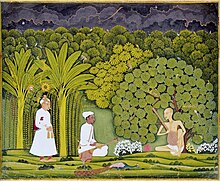Swami Haridas
This article needs additional citations for verification. (September 2008) |


Swami Haridas was a Leela Paarshad (close associate of Supreme God Radha Krishn from the Spiritual World Nikunj GoLok abode) & a spiritual poet incarnated on this material world and classical musician. Credited with a large body of devotional compositions, especially in the Dhrupad style, he is also the founder of the Haridasi school of mysticism, still found today in North India. His work influenced both the classical music and the Bhakti movements of North India, especially those devoted to Krishna's consort Radha. Hit Harivansh Mahaprabhu, Hariram Vyas, Rupa Goswami, Sanatana Goswami, Mahaprabhu Vallabhacharya, Vitthalnath (Gusainji), were his contemporaries.
It is known that he was the direct student of the father of carnatic music, Sangeetha pitha Maha, Daasa-shreshta, Sri Purandara Dasa of Karnataka.
He had many pupils, Tansen being one of them.[1]
Biography
Swami Haridas ji's father was a Saraswat Brahmin from Multan and that their mother's name was Ganga Devi.[2] Their family migrated to a village called Khair wali Sarak, near Aligarh in Uttar Pradesh. Swami Haridas ji was born there in 1512 and the village is now called Haridaspur in their honor. This school holds that they took samadhi at nidhivan in 1607. He was disciple of Shri Ashudheer Maharaj, also his Father who followed the Nimbarka Sampradaya, He is Said to be the Avatar of Shri Lalita Sakhi. He was deeply learned and widely acquainted with the music of his time. Mention is found in his works of stringed instruments such as the kinnari and aghouti, and of drums such as the mridang and daff. He mentions the ragas of Kedar, Gauri (raga), Malhar and Basant. Swami Haridas is said to have been the teacher of Tansen, one of the 'nine gems' of Akbar's court, and the renowned dhrupad singer and composer Baiju.
Swami ji later shifted his residence to Vrindavan, the playground of the immortal cowherd Krishna and Radha. There he built his ashram (hermitage) in Nidhivan and sang his songs of the love of Radha-Krishna. Following the example of Swami Shribhatta, swami Haridas ji continued to praise the Lord until the Lord manifested himself as Sri Banke Bihariji. Swami Haridas ji's' spiritual disciples included Vitthal and Krishna Das who fostered his tradition of devotional music. Groups (samaj, like the sankeertan of Bengal and the bhajana goshti of South India) of devotees came together and sang of the Lord of Vrindavan.
His samadhi (tomb) is in Nidhivan, Vrindavan.[citation needed]
Songs of Swami Haridas
Haridas's compositions may be classed as Vishnupadas. Even his prabandhas that do not refer to Krishna have come to be known as Vishnupadas, perhaps because of the mystic source of his music but also because they are musically constructed in a manner similar to dhrupads. He is also said to have written tirvats, ragamalas and other forms. There are around 128 compositions attributed to him, of which eighteen are philosophical (siddhanta pada) and a hundred and ten devotional (keli mala).
He describes Radha and Krishna's sporting:
Two beams of light are playing -
Unique their dance and music.
Ragas and raginis of heavenly beauty are born,
The two have sunk themselves in the ocean of raga.
Swami Haridas belonged to the tradition of madhura bhakti - Adoration expressed in conjugal imagery.
Haridas's theology embraces not merely the Love of Krishna and Radha but also the witnessing of the Love, a state of mind called rasa. In an ecstatic condition of trance he sings of the play of Krishna among the bowers of Vrindavan. More than Krishna, Radha was the central personality of all his poems.
He says:
Who knows of the quality of things more than Radha?
If anyone has any knowledge at all, it is by her grace.
None knows the beauty of raga, tala and dance as Radha does.
Popular culture
An annual classical music festival, Swami Haridas Sangeet Sammelan is held every year in Mumbai since 1952.
See also
References
- ^ Bonnie C. Wade; Professor of Music Bonnie C Wade (1998). Imaging Sound: An Ethnomusicological Study of Music, Art, and Culture in Mughal India. University of Chicago Press. p. 113. ISBN 978-0-226-86840-0.
- ^ Reginald Massey; Jamila Massey (1996). The Music of India. Abhinav Publications. p. 53. ISBN 978-81-7017-332-8.
